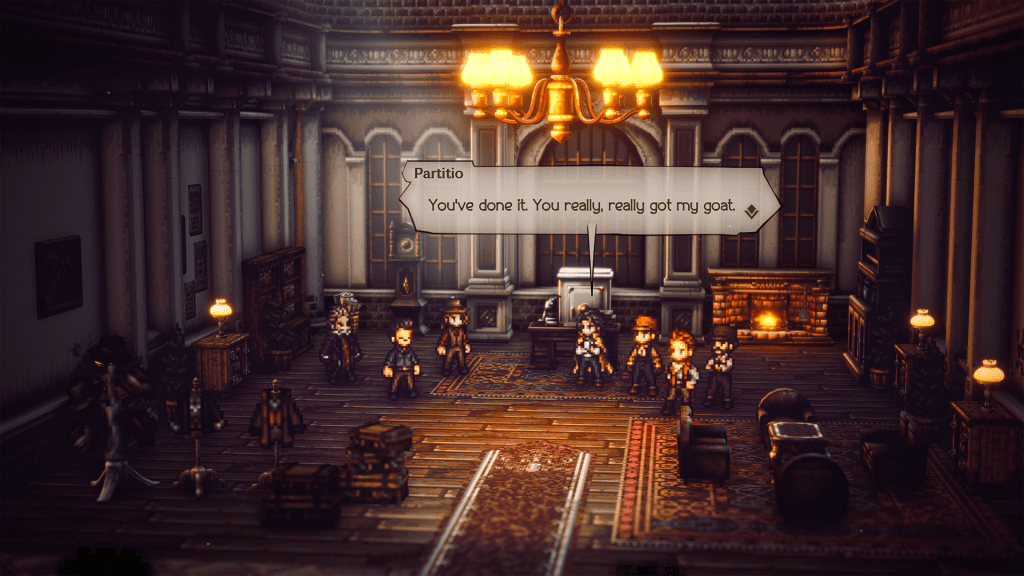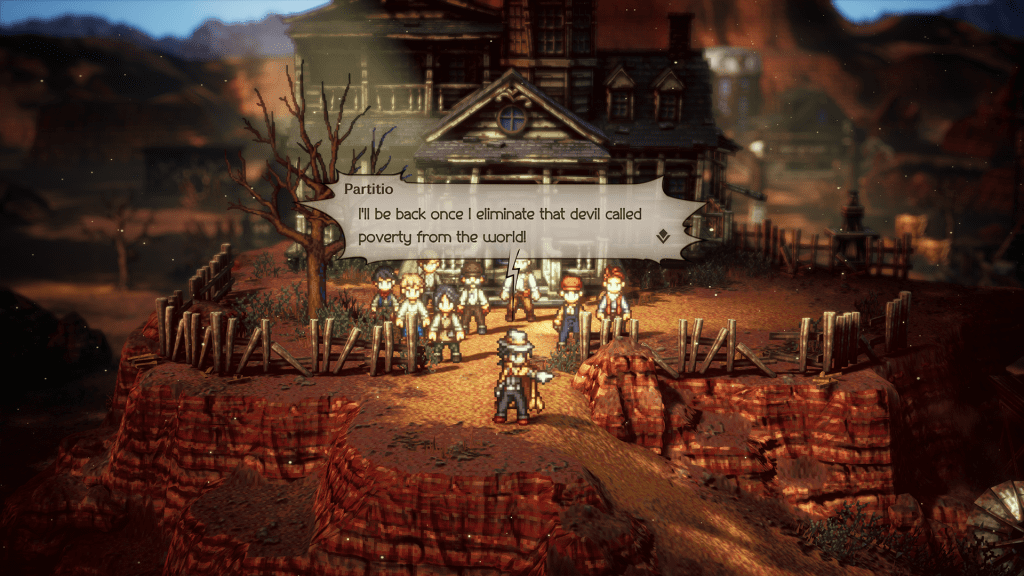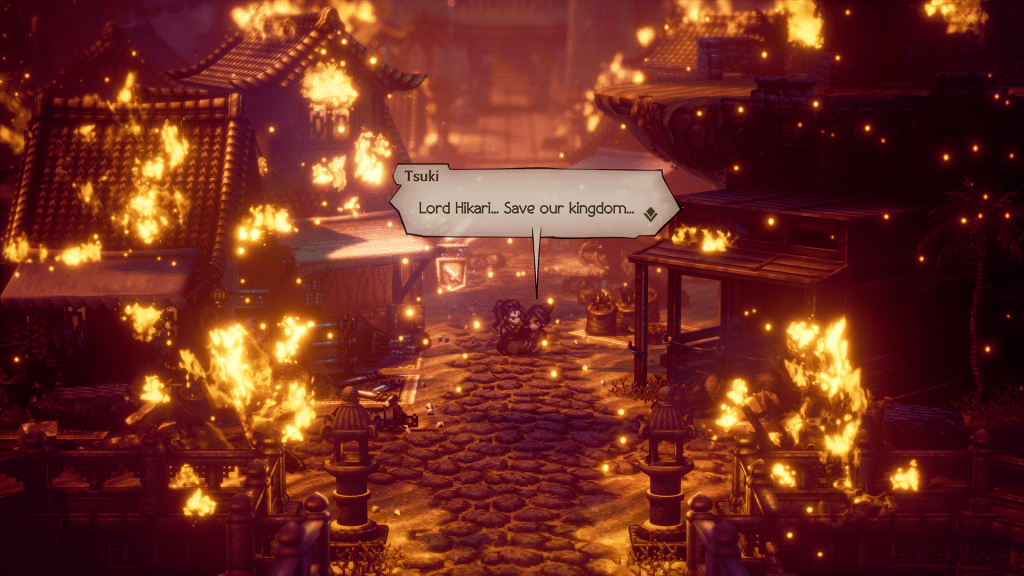Octopath Traveler II is a mesmerizing free fall into why traditional JRPGs are an irreplaceable art form. The sequel from Square Enix and Acquire hits every note that the 2018 original so carefully illustrated – the eight co-protagonists, the hyper-stylized turn-based battle systems, and “HD-2D” visuals that make Final Fantasy VI purists lose consciousness — and it never retreads inspiration to be something it isn’t. It’s still a sequel, of sorts, but instead of being a cash grab or a nostalgic righting of wrongs, it reinterprets what it means to embark on an adventure that’s truly your own.
Octopath Traveler II has a sprawling narrative surrounding eight individual journeys.
Captured on PS5
Structurally, it’s very much a role-playing triumph. Whereas Octopath Traveler detailed the inner workings of Orsterra, a fictional medieval-inspired landscape pitted by religion and desensitized manipulation, Team Asano’s Octopath Traveler II condenses the world of Solistia into a modern depiction of a fictional Industrial Revolution. It’s a realm with eastern and western societies divided by busy sea routes and moral differences, and each central location is a breathtaking Super Nintendo-inspired diorama that demands exploration. As the heart of the Brightlands, New Delsta is a steampunk town defined by theaters, parlors, and 19th century architectural movements; Hinoeuma’s Ryu mirrors Japan’s Edo period with intricate castles and tiger-kissed skies; Winterbloom is Game of Thrones’ Castle Black minus the wights; and even Cropdale and Oresrush aim straight for the eyes as isolated, 16-bit illustrations of the Rocky Mountains and the American Wild West.
Although each region of Solistia is rich with color, history, and a lived-in sense of community, it struggles with differentiating itself from Orsterra as the eight protagonists repurpose the same roles. For better or worse, Throné (Thief) is a Blacksnake determined to free herself from her own cycle of bloodshed. Temenos (Cleric) is an Inquisitor marred by a tragic incident. Ochette (Hunter) is a wildling obsessed with the Night Of The Scarlet Moon. Hikari (Warrior) is a young lord bent on bringing peace to a nation (and inner demons). Castti (Apothecary) is a castaway with retrograde amnesia. Agnea (Dancer) is destined to be a star and symbol of hope. Partitio (Merchant) is a chirpy Kevin Costner-type who won’t shut up about goats or onions. And then there’s Osvald (Scholar), a “revenge dad” with a raging eternal flame in his breast. Their own identities and voiceover work — which can be flipped between English and Japanese at will — shroud repeated path actions, skills, and sub-jobs, but it obstructs Octopath II from being the standalone title that producer Masashi Takahashi wants it to be. Especially since roles like a Blacksmith, Chef, or Musician would be better suited for a world keen on new technologies.

Partitio gives off big Yellowstone vibes.
Captured on PS5
The similarities never get in the way of Octopath Traveler II’s accessibility because Square Enix has always had a passion for world-building. The sequel’s new day and night cycle coexists with additional path actions, one for day and one for night, and being able to toggle between them with the press of a button can provide different opportunities and more difficult adversaries — both in-town and in-battle. There are side quests, shared stories, and an entire sailing subspace with shipwrecks, optional bosses, and unique dungeons only accessible by sea, and in terms of lore, the writers never make compromises. Every townsperson and secondary character has a story worth scrutinizing, whether it’s an elderly man who spent weeks burying the deceased of a village or a famous musician who has found solace in playing the violin on the street corner after years of being confined to performing in a theater. Every anecdote shades in a relevant narrative thread – even the “Aggravated Woman” in New Delsta who hides behind a tree in broad daylight as she prefers to “spend every waking hour” watching the man of her dreams go about his day.

Every character, big and small, has purpose.
Captured on PS5
Those incidental discoveries interpolate varying layers of user-driven exploration and they never feel insignificant in lieu of the series’ infamous combat mechanics. And rest assured, Octopath Traveler II’s battles aren’t for the weak. The “Break” and “Boost” system returns, swapping out turn-based and ATB (active time battle) combat for a pirouette of skill and experimentation that’s crafted for a single purpose: to discern an enemy’s weakness and exploit it. Obtaining gear, skills, and licenses are still important as ever as they can turn a wholesome tavern dancer into a heartless pyromaniac who can hit a Peacock strut, and they’re further amplified by Latent Powers. The new Octopath mechanic is a power gauge, similar to limit breaks in Final Fantasy, that fills up when a traveler takes damage or breaks an enemy’s shield points. They vary in cause and effect, from Castti’s gift of concocting without using materials to Throné’s ability to act twice in a single turn, and in the case of more offensive latent powers, such as Hikari’s Shadow’s Hold, they add context to narratives at work while making use of dynamic battle cameras and stellar original soundtrack.
And Yasunori Nishiki absolutely deserves his flowers for the music of Octopath Traveler II. The Tokyo College of Music grad amassed a few more major credits, including Kingdom Hearts III, Granblue Fantasy Versus, and Final Fantasy VII Remake, and it shows as Octopath II lives by poetic string arrangements. It effortlessly shifts between smooth jazz traditionalism (“Partitio, the Merchant”) and violins that bleed trauma and heartbreak (“Throné, the Thief”), and when the score isn’t moving mountains with theatrical swells (“Hikari, the Warrior”), Nishiki-san is actively synthesizing melodic sensibilities that fit the sweet repose of every town, city, and region’s day and night cycle. The best character in Octopath Traveler II might as well be “Decisive Battle II” as the boss theme taps into pedal tones, diminished chords, and fervid drum fills to send you headfirst into the fight — like a shounen that disregards plot armor. It’s dizzying, yet beautiful.

Despite emulating a 16-bit style, Octopath Traveler II delivers on audiovisual spectacle.
Captured on PS5
Octopath Traveler might have been a love letter to Chrono Trigger and other ‘90s cult classics, but its sequel does what most decline to do: improve in every way and in the most endearing way possible. It suffers from some repetition and while it could spend more time devising new roles that elaborate on character progression and interconnected experiences that are a step beyond travel banter, it’s a 60-plus hour adventure that’s annoyingly difficult to set aside for more than five minutes. If the Super Nintendo era still epitomizes the gold standard of RPG design, then Octopath Traveler II is a dissertation on the future of JRPGs and their unlimited potential.
Octopath Traveler II launches Feb. 24 on PS5, PS4, Switch, and PC. This review is of the PlayStation 5 version.
